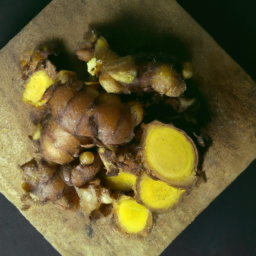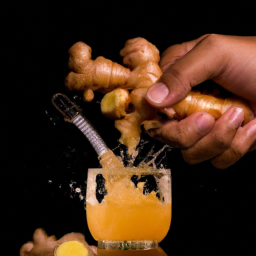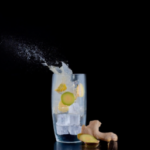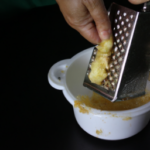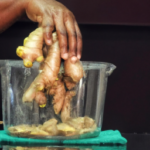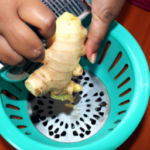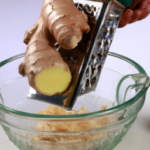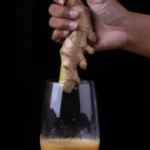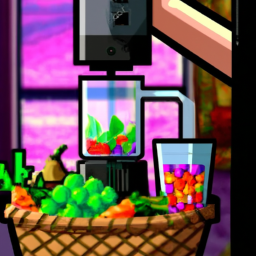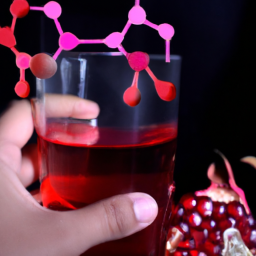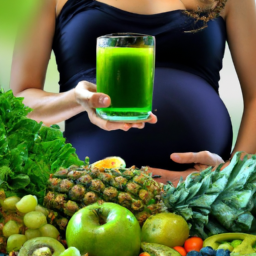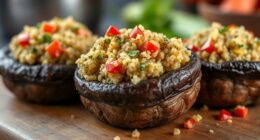I absolutely love ginger juice. It’s so refreshing and offers a variety of health benefits. Ginger helps aid digestion, reduce inflammation, and boost the immune system. That’s why I make sure to have a glass every day.
Making ginger juice may seem daunting at first, but it’s actually quite easy. All you need is fresh ginger root, a juicer or blender, and some optional flavorings. In this article, I’ll walk you through the steps of making ginger juice, from choosing the right ginger root to serving it up in a delicious recipe.
So, grab a ginger root and let’s get started!
Key Takeaways
- Ginger juice can be easily made with fresh ginger root, a juicer or blender, and optional flavorings.
- Properly preparing ginger root involves washing it thoroughly, removing the skin, and cleaning and storing it.
- Ginger juice should be stored properly in the refrigerator or freezer to preserve freshness and flavor.
- Ginger juice can have various health benefits, but it’s important to consult with a healthcare provider before consuming it if you’re on medication.
Benefits of Ginger and Ginger Juice
If you’re looking to reap the benefits of ginger and ginger juice, you’ll want to know that incorporating this potent root into your diet can provide a variety of health benefits. One of the most significant benefits of ginger is its ability to aid in digestion. Drinking ginger juice can help soothe an upset stomach, reduce bloating, and even alleviate nausea.
This is because ginger contains compounds that stimulate digestive enzymes and increase the speed at which food moves through the digestive system. In addition to its digestive benefits, ginger juice can also provide other health benefits when consumed regularly. Studies have shown that drinking ginger juice can help reduce inflammation, boost the immune system, and even lower cholesterol levels.
To get the most out of ginger juice, it’s important to pay attention to the drinking frequency. Drinking a small amount of ginger juice on a daily basis can help you maximize its health benefits. Now, let’s move on to the next section and learn how to choose the right ginger root for making ginger juice.
Choosing the Right Ginger Root
Picking the perfect ginger root is like choosing a ripe fruit at the market. It is important to select quality ginger root that is fresh, firm, and has a smooth skin. When choosing ginger root, there are different types available such as baby ginger, mature ginger, and wild ginger. Baby ginger is young and tender, while mature ginger has a stronger flavor and aroma. Wild ginger, on the other hand, is not recommended for consumption as it may be toxic.
To help you choose the right ginger root, refer to the table below:
| Type of Ginger Root | Characteristics | Best Use |
|---|---|---|
| Baby Ginger | Young and tender with thin skin | Ideal for pickling and making ginger juice |
| Mature Ginger | Firm, woody, and has a thick skin | Best for cooking and making ginger tea |
| Wild Ginger | Not recommended for consumption | Toxic and may cause health problems |
When selecting ginger root, it is important to check for any signs of spoilage such as mold, wrinkles, or soft spots. Fresh ginger root should also have a spicy, pungent scent. By choosing the right type of ginger root, you can enhance the flavor and nutritional benefits of your ginger juice.
Now that we know how to choose the perfect ginger root, let’s move on to preparing it for making ginger juice.
Preparing the Ginger Root
To achieve high-quality ginger juice, it’s crucial to properly prepare the ginger root. This involves washing it thoroughly and removing the skin with a peeler or spoon. Some people prefer to use a knife for peeling, but using a peeler is safer and easier for those who are not confident with their knife skills.
To use a peeler, simply hold the ginger root firmly and scrape off the skin in a downward motion. Make sure to remove any bumps or knots on the surface as they can be tough and fibrous.
Cleaning and storing ginger root is also important in ensuring that the juice tastes fresh and flavorful. After peeling, rinse the ginger root under running water to remove any dirt or debris. Pat it dry with a paper towel and store it in a plastic bag or container in the refrigerator. This will help to keep it fresh for up to a week.
When it’s time to make the juice, simply take out the required amount and prepare it according to your preference using a juicer or blender. Now that the ginger root is properly prepared, it’s time to move on to the next step of making ginger juice.
Using a Juicer or Blender
Alright, now that I’ve got my ginger peeled and chopped up, it’s time to make some ginger juice!
One way to make ginger juice is to use a juicer. Another option is to blend the ginger with some water in a blender.
Once blended, the mixture can be strained to remove any pulp.
Let’s explore these methods in more detail.
Juicing with a Juicer
Using a juicer is the easiest and most efficient way to extract ginger juice for all your health needs. There are a few juicing techniques to consider when preparing ginger. First, wash the ginger root and cut it into small pieces. Then, add the ginger into the juicer and extract the juice. You can also add other fruits or vegetables to the juicer to create a delicious and nutritious juice. Here are some juicing recipes that you can try:
| Juice Recipe | Ingredients |
|---|---|
| Ginger Blast | 1 small ginger root, 1 medium-sized apple, 1/2 lemon, 2 celery sticks |
| Ginger and Greens | 1 small ginger root, 2 cups spinach, 1/2 cucumber, 1 medium-sized apple |
Juicing ginger can provide numerous health benefits such as relieving nausea, reducing inflammation, and improving digestion. However, if you do not have a juicer, blending with a blender is another option to extract ginger juice.
Blending with a Blender
Blending ginger with a blender is a simple and effective method for extracting its juice, and it can be done easily at home. To get started, you’ll need fresh ginger, a blender, and water.
Begin by peeling the ginger and cutting it into small pieces. Place the ginger into the blender, add a small amount of water, and blend the mixture until it becomes a smooth paste.
There are several blending techniques to consider when making ginger juice. For instance, you can add other ingredients such as lemon, honey, or mint to customize the flavor. Another technique is to freeze the ginger before blending it, which can help to break down the fibers and produce a smoother consistency.
Once you have blended the ginger, the next step is to strain the pulp to remove any remaining fibers and solids.
Straining the Pulp
Now that we’ve blended the ginger root with water, the next step is to strain the pulp from the juice. Removing pulp is important for a smoother texture and to prevent any bits from getting stuck in your teeth.
There are several strainer options to choose from, such as a fine mesh strainer or a nut milk bag. Personally, I prefer using a nut milk bag as it allows for maximum extraction of juice while also capturing any remaining pulp.
Simply place the bag over a large bowl and pour the blended mixture into the bag. Squeeze the bag tightly to extract as much juice as possible. Alternatively, you can use a fine mesh strainer by placing it over a bowl and pouring the blended mixture into the strainer.
Use a spoon or spatula to press down on the pulp and extract as much juice as possible. Repeat this process until all the juice has been extracted. Once you have strained the pulp, the ginger juice is ready to be consumed as is or to be used as a base for other drinks.
Now, let’s move on to the next step of adding flavor and sweetness to our ginger juice.
Adding Flavor and Sweetness
When it comes to adding flavor and sweetness to your ginger juice, there are a few key ingredients that I always reach for.
First up, lemon or lime juice can add a bright, citrusy note that complements the spicy ginger perfectly.
If you like your juice a little sweeter, you can also add honey or agave syrup, which add a natural sweetness without overpowering the ginger.
Finally, for a refreshing twist, try adding a few mint or basil leaves to your juice. They add a herbal, slightly cooling note that balances out the warmth of the ginger.
Lemon or Lime Juice
To add a tangy twist to your ginger juice, you can squeeze in some fresh lemon or lime juice. Both lemon and lime are excellent sources of vitamin C, which is an important antioxidant that can help boost your immune system.
However, lemon juice has a slightly sweeter taste than lime juice, while lime juice has a more tart and acidic flavor. Aside from their flavor profiles, adding lemon or lime juice to your ginger juice can provide various health benefits.
Lemon juice is known to aid in digestion and detoxification, while lime juice has been shown to have anti-inflammatory properties. Both fruits also contain flavonoids and other compounds that may help protect against chronic diseases such as cancer and heart disease.
So, whether you choose to use lemon or lime in your ginger juice, you can be sure that you are adding a nutritious kick to your drink. To further enhance the flavor of your ginger juice, you can also add some honey or agave syrup for sweetness.
Honey or Agave Syrup
Looking for a way to sweeten up your ginger juice? Try adding a drizzle of honey or agave syrup for a delicious and nutritious boost.
Both honey and agave syrup are natural sweeteners that can add a touch of sweetness to your ginger juice without the harmful effects of processed sugar. However, there are some differences between the two.
Honey vs agave syrup: While both honey and agave syrup are natural sweeteners, honey has a higher glycemic index than agave syrup. This means that honey can cause a sharper spike in blood sugar levels compared to agave syrup.
On the other hand, honey has more antioxidants and antibacterial properties than agave syrup. Agave syrup, on the other hand, has a lower glycemic index and is suitable for people with diabetes. It also has a sweeter taste than honey, so you may need less of it to sweeten your ginger juice. Ultimately, it comes down to personal preference and health needs.
Incorporating natural sweeteners like honey and agave syrup into your ginger juice can offer health benefits such as providing antioxidants and supporting digestive health.
Now that you know how to sweeten up your ginger juice, why not add a refreshing twist with some mint or basil leaves?
Mint or Basil Leaves
If you want to take your ginger juice to the next level, try adding mint or basil leaves for a burst of fresh and invigorating flavor reminiscent of a summer garden party. Mint leaves have a cooling effect that complements the spiciness of ginger, making it a perfect combination for hot summer days.
You can even use mint tea to infuse the ginger juice with an added layer of complexity. Basil leaves, on the other hand, provide a sweet and savory aroma that pairs well with ginger and can even be used to make a delicious basil pesto to accompany your ginger juice.
Using mint or basil leaves in your ginger juice not only enhances its flavor but also adds a nutritional boost. Mint leaves contain antioxidants and anti-inflammatory compounds that can help improve digestion and reduce stress. Basil leaves, on the other hand, are a good source of vitamin K, which plays a vital role in maintaining bone health.
So, next time you make ginger juice, don’t be afraid to experiment with mint or basil leaves for a refreshing and nutritious twist.
To keep your ginger juice fresh and flavorful, it’s important to store it properly. In the next section, I’ll share some tips on how to store your ginger juice to ensure it stays fresh for as long as possible.
Storing Ginger Juice
When I make ginger juice, I always end up with more than I need. So, to avoid wasting it, I store it properly.
There are three ways to store ginger juice: refrigeration, freezing, and keeping it at room temperature. Refrigerating the juice extends its shelf life up to a week, while freezing it can preserve it for up to three months.
Refrigeration
Proper refrigeration is essential for preserving the freshness and flavor of homemade ginger juice. Here are three important things to keep in mind when storing your ginger juice in the refrigerator:
-
Store in an airtight container: This’ll prevent any unwanted exposure to air that can cause the ginger juice to spoil quickly. Good options include glass jars with tight-fitting lids or plastic containers with snap-on lids.
-
Keep in the back of the refrigerator: The back of the refrigerator is the coldest part and will help keep the ginger juice fresh for longer periods of time. Avoid storing the ginger juice in the door because it is exposed to more temperature changes due to frequent opening and closing.
-
Use within 7 days: While ginger juice can last up to 2 weeks in the refrigerator, it’s best to use it within 7 days for the best flavor and freshness.
When freezing ginger juice, there are a few steps you can take to ensure it maintains its quality.
Freezing
To preserve the freshness of your ginger elixir for a longer period, imagine freezing it is like putting it in a time capsule. Freezing ginger juice is not only convenient but also a great way to add some zing to your cocktails. It’s also a great way to add flavor to smoothies, marinades, and dressings.
Before freezing, make sure to strain the ginger juice to remove any pulp or residue. Pour the juice into ice cube trays or freezer-safe containers and leave it in the freezer until you’re ready to use it again.
Simply add a ginger juice ice cube to your favorite cocktail for a spicy twist. Now that we’ve covered freezing, let’s move on to the next section about the shelf life.
Shelf Life
You can keep your ginger elixir fresh for a longer period by storing it in a tightly sealed glass jar and keeping it in the refrigerator. This will help preserve the nutrients in the ginger juice and prevent spoilage.
It’s important to note that ginger juice, like any other fresh juice, has a limited shelf life and can go bad quickly if not stored properly. To extend the shelf life of your ginger juice, it’s recommended to consume it within 3-4 days after preparation.
If you have excess ginger juice, you can freeze it in ice cube trays and use it later for cooking or making smoothies. However, it’s important to note that freezing can cause some loss of flavor and nutrients.
Overall, to get the most out of your ginger juice, it’s best to prepare it in small batches and store it in the refrigerator for no more than 4 days.
When serving ginger juice, there are many creative ways to enjoy its unique flavor and health benefits. Let’s explore some delicious and nutritious recipes that incorporate ginger juice!
Serving Ginger Juice
Now, if you wanna get fancy, you can serve your ginger juice in a chilled glass with a sprig of mint as a garnish. It’s a refreshing and healthy drink that can be enjoyed any time of the day.
Ginger juice is known for its health benefits, including reducing inflammation, aiding digestion, and boosting immunity. Aside from serving it plain, there are many serving suggestions for ginger juice.
Some people like to mix it with other juices, such as orange or pineapple, to add some sweetness. Others prefer to add a squeeze of lemon or lime for a tart kick. Whatever your preference is, ginger juice is a versatile ingredient that can be used in various recipes.
Speaking of which, let’s move on to some delicious recipes with ginger juice.
Recipes with Ginger Juice
Get ready to indulge in some mouth-watering recipes that feature the versatile ingredient of ginger juice. Ginger juice cocktails are a popular way of incorporating the benefits of ginger into your drinks. You can mix ginger juice with vodka, gin, or rum to create a refreshing drink that’s perfect for a summer afternoon.
For a non-alcoholic option, mix ginger juice with sparkling water and lemon juice for a refreshing ginger lemonade. Ginger juice also has a variety of culinary uses. You can use it to marinate meat, add flavor to soups and stews, and even bake with it. Add ginger juice to your stir fry or sautéed vegetables for a unique flavor twist.
In baking, ginger juice can be used in place of ginger powder for a more intense ginger flavor. The possibilities are endless when it comes to incorporating ginger juice into your cooking and drinks! Now that you have some ideas for how to use ginger juice, it’s important to remember to use caution when consuming it.
While ginger juice can provide many health benefits, it can also cause stomach upset in some individuals. As with any new ingredient, start with a small amount and gradually increase as tolerated.
Health Precautions
It’s important to be cautious when consuming ginger juice, as it may cause stomach upset in some individuals. Therefore, starting with a small amount and gradually increasing it is recommended.
Additionally, there are some health precautions that should be taken into consideration when making ginger juice.
To prevent contamination, it’s important to wash the ginger root thoroughly before juicing it. This will help remove any dirt or debris that may have accumulated on the surface of the root.
It’s also important to use clean equipment when making the juice. This includes using a clean juicer or blender, as well as clean utensils and containers.
Another important consideration is how ginger juice may interact with medication. Ginger is known to have blood-thinning properties, which can be problematic for individuals taking certain medications such as blood thinners.
Therefore, it’s important to consult with a healthcare provider before consuming ginger juice if you are taking any medications.
By taking these precautions, you can enjoy the benefits of ginger juice while minimizing any potential risks.
Frequently Asked Questions
Can you use any type of ginger root for making ginger juice?
Fresh ginger roots are best for making ginger juice. The taste is tangy and tantalizing. Different types of ginger roots are available but fresh ones provide maximum health benefits.
How long can ginger juice last in the refrigerator?
Ginger juice can last up to a week when stored in the refrigerator. Its shelf life can be extended by adding lemon juice or honey. It’s important to use clean utensils and store in airtight containers to prevent contamination.
Can ginger juice be frozen for later use?
To preserve ginger juice, I recommend freezing it for later use. Freezing the juice is a great way to extend its shelf life without compromising its flavor or nutritional value. Simply pour the juice into an ice cube tray, freeze, and then transfer the cubes to a freezer-safe bag or container for storage.
What are some common side effects of consuming ginger juice?
Possible output: As someone who drinks ginger shots regularly, I can attest to their ability to prevent nausea. However, consuming large amounts of ginger juice can lead to heartburn, stomach upset, and diarrhea. It’s important to consume in moderation.
Is it necessary to peel the ginger root before juicing or blending it?
Peeling ginger is a personal preference. Some enjoy the added texture and nutrients from leaving the skin on, while others find the taste too strong. However, peeling can reduce bitterness and make the juice smoother.
Conclusion
Overall, making ginger juice is a simple process that can provide numerous health benefits. Ginger has been used for centuries as a natural remedy to reduce inflammation and aid digestion.
To make ginger juice, start by choosing a fresh and firm ginger root. Then, wash and peel it. You can use a juicer or blender to extract the juice, and add flavor and sweetness to taste.
Remember to store your ginger juice properly to ensure freshness and potency. You can serve ginger juice as a standalone beverage or use it as an ingredient in recipes like smoothies and cocktails. However, it’s important to note that ginger may interact with certain medications and should be consumed in moderation.
As the saying goes, "a little goes a long way"when it comes to ginger juice. So, enjoy the benefits of this spicy root in moderation and with caution.
Ilana has been a vegan for over 10 years. She originally made the switch for health reasons, but soon found herself becoming more and more passionate about the ethical and environmental implications of a vegan lifestyle. Ilana is the author of The Graceful Kitchen, a blog all about veganism. She loves to cook up delicious and nutritious vegan meals, and share her recipes with others who are interested in leading a cruelty-free life. Ilana is also a strong advocate for using whole foods as the foundation of a healthy diet, and believes that going vegan is one of the best ways to achieve this.
